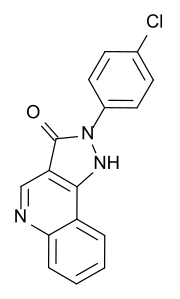CGS-9896
CGS-9896 is an anxiolytic drug used in scientific research. It has similar effects to benzodiazepine drugs but is structurally distinct and so is classed as a nonbenzodiazepine anxiolytic.[1]
 | |
| Clinical data | |
|---|---|
| ATC code |
|
| Identifiers | |
IUPAC name
| |
| CAS Number | |
| PubChem CID | |
| ChemSpider | |
| Chemical and physical data | |
| Formula | C16H10ClN3O |
| Molar mass | 295.7231 g/mol g·mol−1 |
| 3D model (JSmol) | |
SMILES
| |
InChI
| |
| | |
CGS-9896 is a benzodiazepine receptor partial agonist which produces long-lasting anxiolytic and anticonvulsant effects in animal studies but does not produce sedative effects.[2][3] It also increases appetite,[4] and reduces the development of gastrointestinal ulcers following chronic stress.[5]
References
- Leidenheimer NJ, Schechter MD (Oct 1988). "Discriminative stimulus properties of CGS 9896: interactions within the GABA/benzodiazepine receptor complex". Pharmacol Biochem Behav. 31 (2): 249–54. doi:10.1016/0091-3057(88)90342-5. PMID 2854261.
- Bernasconi R, Marescaux C, Vergnes M, et al. (1988). "Evaluation of the anticonvulsant and biochemical activity of CGS 8216 and CGS 9896 in animal models". J Neural Transm. 71 (1): 11–27. doi:10.1007/BF01259406. PMID 3343593.
- Rump S, Raszewski W, Gidynska T, Galecka E (1990). "Effects of CGS 9896 in acute experimental intoxication with fluostigmine". Arch. Toxicol. 64 (5): 412–3. doi:10.1007/BF01973465. PMID 2206111.
- Chen SW, Davies MF, Loew GH (1995). "Food palatability and hunger modulated effects of CGS 9896 and CGS 8216 on food intake". Pharmacol Biochem Behav. 51 (2–3): 499–503. doi:10.1016/0091-3057(95)00020-W. PMID 7667375.
- Najim RA, Karim KH (Feb 1990). "Effect of CGS 9896 on stress-induced gastric ulcer in rat". Clin Exp Pharmacol Physiol. 17 (2): 157–161. doi:10.1111/j.1440-1681.1990.tb01298.x. PMID 2109664.
This article is issued from
Wikipedia.
The text is licensed under Creative
Commons - Attribution - Sharealike.
Additional terms may apply for the media files.